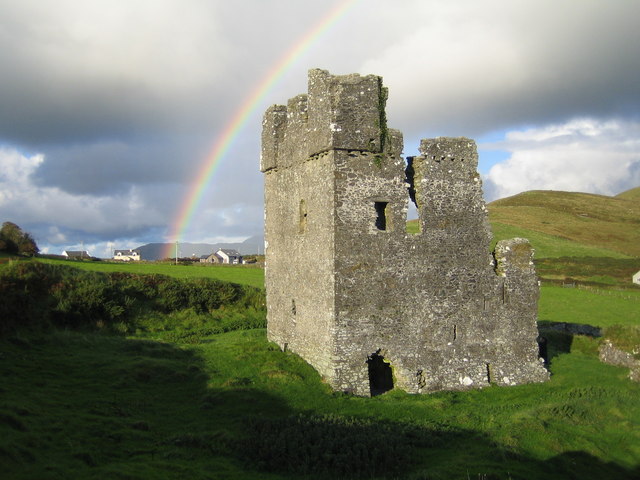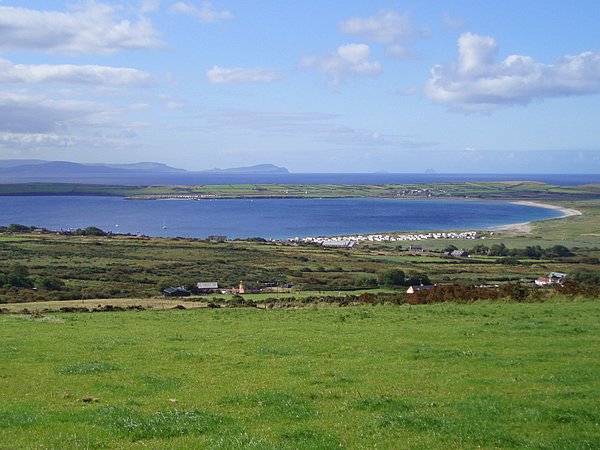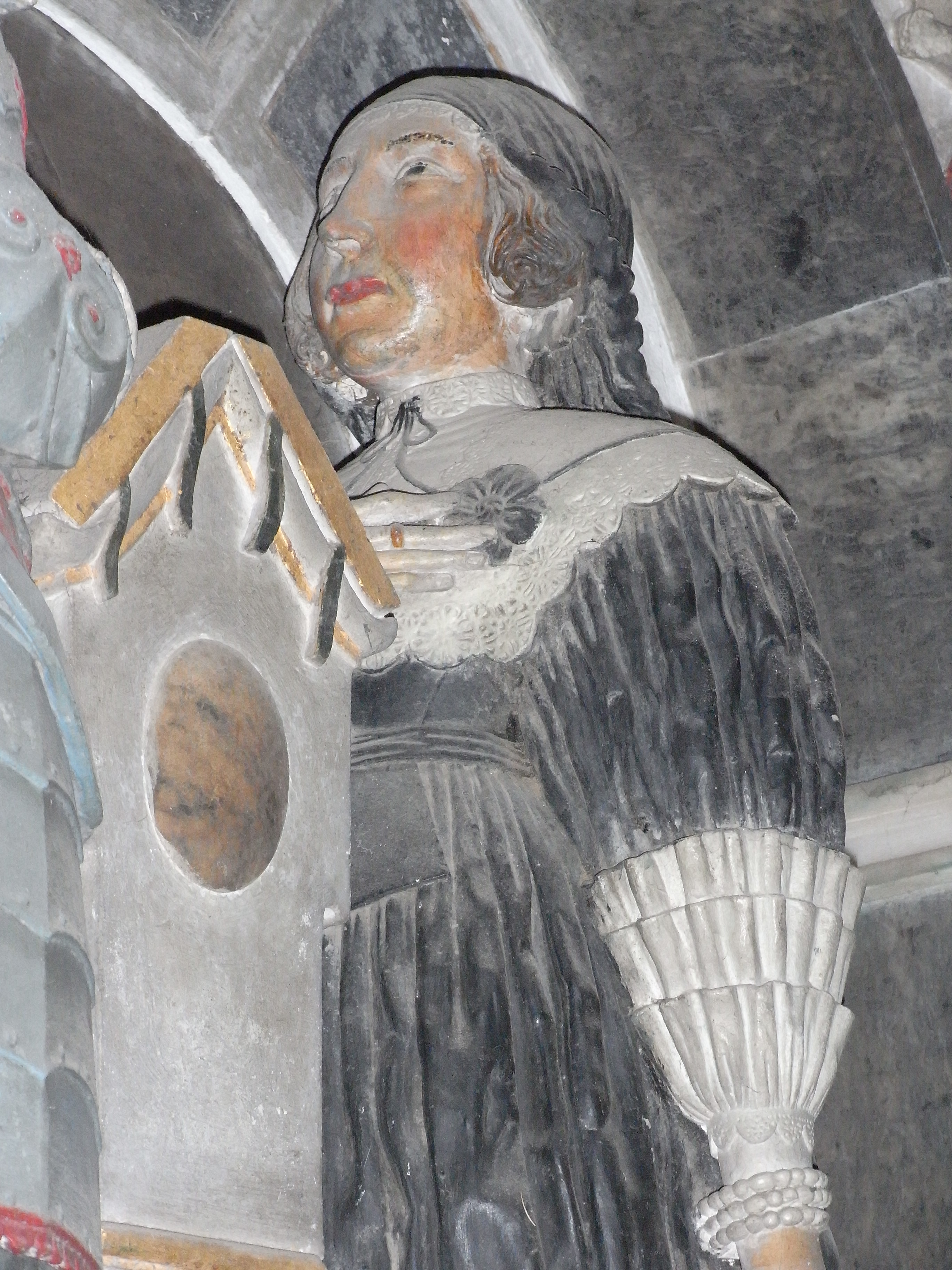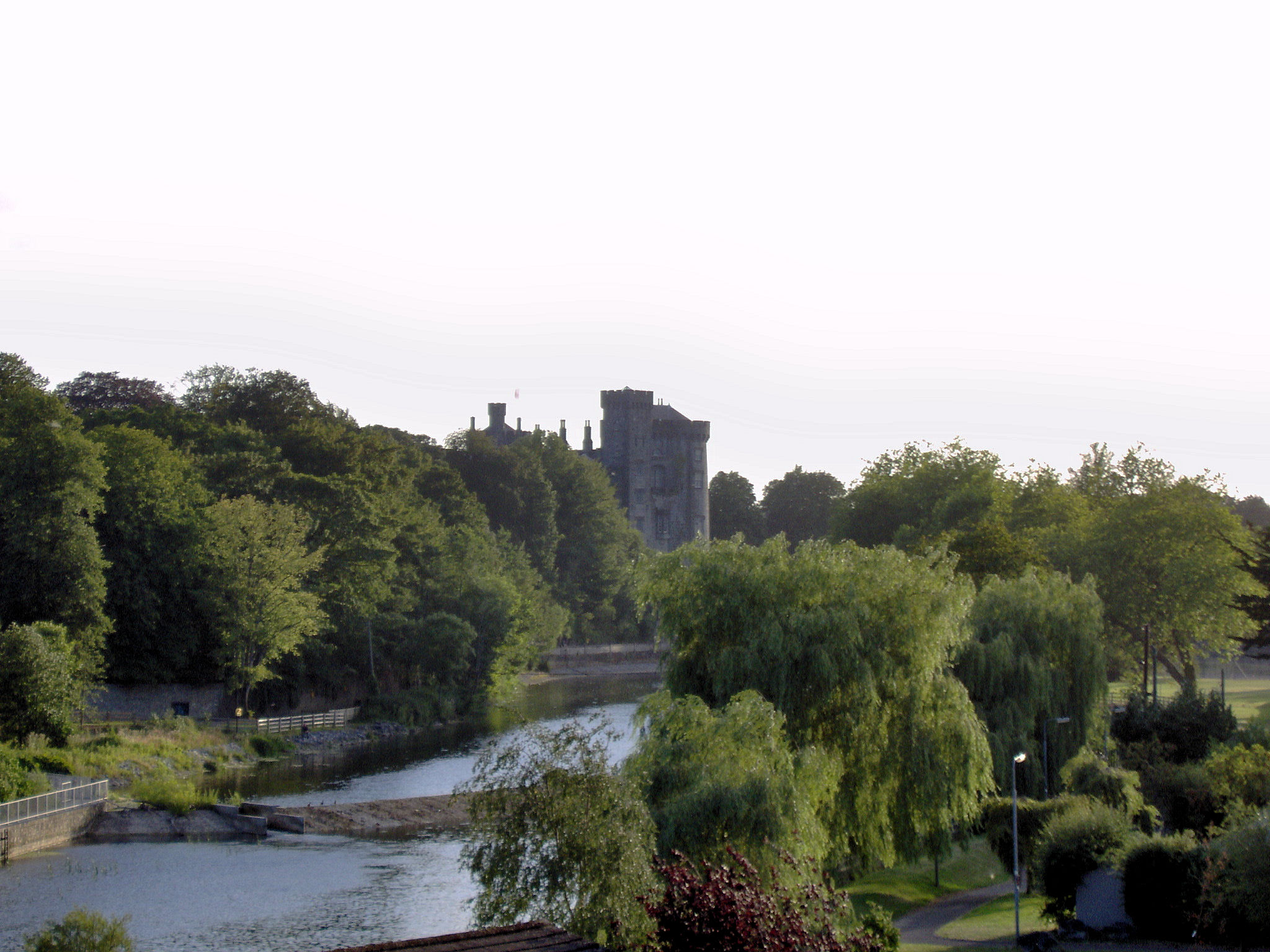|
Rahinnane Castle
Rahinnane Castle is a tower house and National Monument located in County Kerry, Ireland. Location Rahinnane Castle is located northwest of Ventry, in the west of the Dingle Peninsula. History The ringfort on the site was built in the 7th or 8th century AD. The Irish name was originally ''Rath Fhionnáin'' — Finan's ringfort. Local tradition once claimed that this piece of land was the last in Ireland held by the Vikings, as it was so easily defended. The stone tower house was built in the 15th or 16th century by the FitzGeralds, hereditary Knights of Kerry. In 1602, towards the end of the Nine Years' War, the castle was taken by Sir Charles Wilmot. It was ruined during the Cromwellian conquest (1649–53). Building The ancient earthwork featured a deep ditch, an entrance in the southwest and a souterrain in the southeast. The castle was rectangular and three storeys tall. Most of the outer walls remain; on the inside there is some mural stairway, traces of vaulti ... [...More Info...] [...Related Items...] OR: [Wikipedia] [Google] [Baidu] |
Knight Of Kerry
Knight of Kerry (), also called The Green Knight, is one of three Hiberno-Norman hereditary knighthoods, all of which existed in Ireland since feudal times. The other two were The White Knight (surname fixed as Fitzgibbon), being dormant since the 19th century, and the Knight of Glin (The Black Knight), dormant since 2011. All three belong to the FitzMaurice/FitzGerald Dynasty commonly known as the Geraldines being created by the Earls of Desmond for their kinsmen. Sir Maurice Buidhe FitzJohn, 1st Knight of Kerry, was the illegitimate son of John FitzGerald, 1st Baron Desmond (d. 1261 Battle of Callann), son of Thomas FitzMaurice, Lord OConnello, son of Maurice FitzGerald, Lord of Lanstephan, son of the Princess Nest ferch Rhys of Deheubarth and Gerald de Windsor. Knights of Kerry * Sir Maurice Buidhe FitzJohn, 1st Knight of Kerry * Sir Richard FitzMaurice, 2nd Knight of Kerry * Sir Maurice FitzRichard, 3rd Knight of Kerry (married Margaret de Courcy in 1382) * Sir ... [...More Info...] [...Related Items...] OR: [Wikipedia] [Google] [Baidu] |
Ventry
Ventry (), officially ''Ceann Trá'', . is a village in , , on the , 7 kilometres west of |
Charles Wilmot, 1st Viscount Wilmot
Charles Wilmot, 1st Viscount Wilmot of Athlone (c. 1572 – 1644) was an English soldier active in Ireland. Life He was the son of Edward Wilmot of Culham (otherwise of Newent, Gloucestershire and Witney, Oxfordshire) and Elizabeth Stafford. On 6 July 1587 he matriculated at Magdalen College, Oxford, aged 16, but left the university without a degree, and took service in the Irish wars, perhaps in attendance on his neighbour, Sir Thomas Norris, who was also a member of Magdalen College. In 1592 he became a captain, and early in 1595 he was sent to Newry; in the same year he was also in command of sixty foot at Carrickfergus. In 1597 Norris, now President of Munster, made Wilmot sergeant-major of the forces in that province; he was promoted colonel in 1598. He was knighted by Robert Devereux, 2nd Earl of Essex at Dublin on 5 August 1599, and on the 16th was sent with instructions to the council of Munster for its government during Norris's illness. On 23 June 1600 Charles Bl ... [...More Info...] [...Related Items...] OR: [Wikipedia] [Google] [Baidu] |
Turret (architecture)
In architecture, a turret is a small tower that projects vertically from the wall of a building such as a medieval castle. Turrets were used to provide a projecting defensive position allowing covering fire to the adjacent wall in the days of military fortification. As their military use faded, turrets were used for decorative purposes, as in the Scottish baronial style. A turret can have a circular top with crenellations as seen in the picture at right, a pointed roof, or other kind of apex. It might contain a staircase if it projects higher than the building; however, a turret is not necessarily higher than the rest of the building; in this case, it is typically part of a room, that can be simply walked into – see the turret of Chateau de Chaumont on the collection of turrets, which also illustrates a turret on a modern skyscraper. A building may have both towers and turrets; towers might be smaller or higher, but turrets instead project from the edge of a buildin ... [...More Info...] [...Related Items...] OR: [Wikipedia] [Google] [Baidu] |
Blind Arcade
A blind arcade or blank arcade is an arcade (a series of arches) that has no actual openings and that is applied to the surface of a wall as a decorative element: i.e., the arches are not windows or openings but are part of the masonry face. It is designed as an ornamental architectural element and has no load-bearing function. Similar structures Whereas a blind arch is usually a single arch or a series of joined arches as a frieze (sometimes called Lombard band), a blind arcade is composed of a series of arches that have well-defined columns in between its arches. A blind arcade may resemble several s (false/blank windows or sealed-up windows) or blind niches that are side by side. Examples Blind arcades are a common decorative features on the facades of Romanesque and Gothic buildings throughout Western Europe, and are also a common feature in Byzantine Orthodox churches in Eastern Europe, and in Armenian churches. See also * Dwarf gallery * Flying butress Ima ... [...More Info...] [...Related Items...] OR: [Wikipedia] [Google] [Baidu] |
Vault (architecture)
In architecture, a vault (French ''voûte'', from Italian ''volta'') is a self-supporting arched form, usually of stone or brick, serving to cover a space with a ceiling or roof. As in building an arch, a temporary support is needed while rings of voussoirs are constructed and the rings placed in position. Until the topmost voussoir, the keystone, is positioned, the vault is not self-supporting. Where timber is easily obtained, this temporary support is provided by centering consisting of a framed truss with a semicircular or segmental head, which supports the voussoirs until the ring of the whole arch is completed. Vault types Corbelled vaults, also called false vaults, with horizontally joined layers of stone have been documented since prehistoric times; in the 14th century BC from Mycenae. They were built regionally until modern times. The real vault construction with radially joined stones was already known to the Egyptians and Assyrians and was introduced into the buil ... [...More Info...] [...Related Items...] OR: [Wikipedia] [Google] [Baidu] |
Souterrain
''Souterrain'' (from French ''sous terrain'', meaning "under ground") is a name given by archaeologists to a type of underground structure associated mainly with the European Atlantic Iron Age. These structures appear to have been brought northwards from Gaul during the late Iron Age. Regional names include earth houses, fogous and Pictish houses. The term ''souterrain'' has been used as a distinct term from ''fogou'' meaning 'cave'. In Cornwall the regional name of ''fogou'' ( Cornish for 'cave') is applied to souterrain structures. The design of underground structures has been shown to differ among regions; for example, in western Cornwall the design and function of the fogou appears to correlate with a larder use. Etymology The name ''souterrain'' comes from the French language (''sous-terrain'' or ''souterrain''), in which it means "underground passageway" or refers to subterranea in general. In languages other than English, it is sometimes used to mean "basement", especi ... [...More Info...] [...Related Items...] OR: [Wikipedia] [Google] [Baidu] |
Cromwellian Conquest Of Ireland
The Cromwellian conquest of Ireland or Cromwellian war in Ireland (1649–1653) was the re-conquest of Ireland by the forces of the English Parliament, led by Oliver Cromwell, during the Wars of the Three Kingdoms. Cromwell invaded Ireland with the New Model Army on behalf of England's Rump Parliament in August 1649. Following the Irish Rebellion of 1641, most of Ireland came under the control of the Irish Catholic Confederation. In early 1649, the Confederates allied with the English Royalists, who had been defeated by the Parliamentarians in the English Civil War. By May 1652, Cromwell's Parliamentarian army had defeated the Confederate and Royalist coalition in Ireland and occupied the country, ending the Irish Confederate Wars (or Eleven Years' War). However, guerrilla warfare continued for a further year. Cromwell passed a series of Penal Laws against Roman Catholics (the vast majority of the population) and confiscated large amounts of their land. As punishment ... [...More Info...] [...Related Items...] OR: [Wikipedia] [Google] [Baidu] |
Nine Years' War (Ireland)
The Nine Years' War, sometimes called Tyrone's Rebellion, took place in Ireland from 1593 to 1603. It was fought between an Irish alliance—led mainly by Hugh O'Neill of Tyrone and Hugh Roe O'Donnell of Tyrconnell—against English rule in Ireland, and was a response to the ongoing Tudor conquest of Ireland. The war was fought in all parts of the country, but mainly in the northern province of Ulster. The Irish alliance won some important early victories, such as the Battle of Clontibret (1595) and the Battle of the Yellow Ford (1598), but the English won a victory against the alliance and their Spanish allies in the siege of Kinsale (1601–02). The war ended with the Treaty of Mellifont (1603). Many of the defeated northern lords left Ireland to seek support for a new uprising in the Flight of the Earls (1607), never to return. This marked the end of Gaelic Ireland and led to the Plantation of Ulster. The war against O'Neill and his allies was the largest conflict ... [...More Info...] [...Related Items...] OR: [Wikipedia] [Google] [Baidu] |
County Kerry
County Kerry ( gle, Contae Chiarraí) is a county in Ireland. It is located in the South-West Region and forms part of the province of Munster. It is named after the Ciarraige who lived in part of the present county. The population of the county was 155,258 at the 2022 census, A popular tourist destination, Kerry's geography is defined by the MacGillycuddy's Reeks mountains, the Dingle, Iveragh and Beara peninsulas, and the Blasket and Skellig islands. It is bordered by County Limerick to the north-east and Cork County to the south and south-east. Geography and subdivisions Kerry is the fifth-largest of Ireland's 32 traditional counties by area and the 16th-largest by population. It is the second-largest of Munster's six counties by area, and the fourth-largest by population. Uniquely, it is bordered by only two other counties: County Limerick to the east and County Cork to the south-east. The county town is Tralee although the Catholic diocesan seat is Killarne ... [...More Info...] [...Related Items...] OR: [Wikipedia] [Google] [Baidu] |
Viking
Vikings ; non, víkingr is the modern name given to seafaring people originally from Scandinavia (present-day Denmark, Norway and Sweden), who from the late 8th to the late 11th centuries raided, pirated, traded and settled throughout parts of Europe.Roesdahl, pp. 9–22. They also voyaged as far as the Mediterranean, North Africa, Volga Bulgaria, the Middle East, and North America. In some of the countries they raided and settled in, this period is popularly known as the Viking Age, and the term "Viking" also commonly includes the inhabitants of the Scandinavian homelands as a collective whole. The Vikings had a profound impact on the early medieval history of Scandinavia, the British Isles, France, Estonia, and Kievan Rus'. Expert sailors and navigators aboard their characteristic longships, Vikings established Norse settlements and governments in the British Isles, the Faroe Islands, Iceland, Greenland, Normandy, and the Baltic coast, as well as ... [...More Info...] [...Related Items...] OR: [Wikipedia] [Google] [Baidu] |
_-_geograph.org.uk_-_219820.jpg)






_2.jpg)
